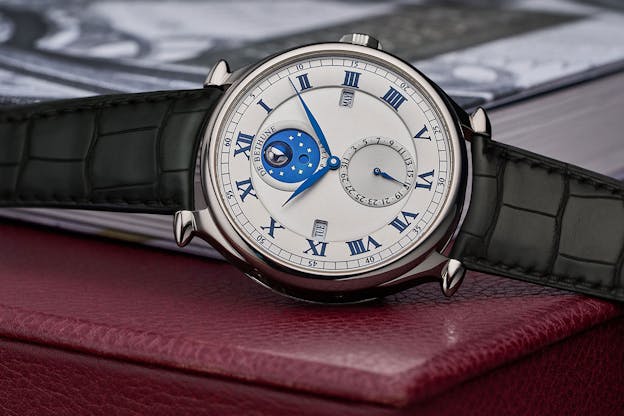A Revolution In Design: The De Bethune DBS
Old school new wave watchmaking.
One of the most fascinating watches De Bethune has ever produced is the DBS, and it’s important on a number of different levels – for the company of course, as it represents a remarkable leap forward in De Bethune’s design language, but also in the larger context of the evolution of watchmaking in the first years of the 2000s. The DBS originally came out in 2005, and in retrospect, the connection between its design features and the earlier De Bethune watches seem obvious but at the time it was such a departure from business as usual that it almost felt like something from a different watch company.

The DBS is exotic. The case is shaped somewhat like a horseshoe, with the signature De Bethune ogival lugs at the bottom (“ogival” or “ogive” refers to a type of pointed Gothic arch). Up top is the winding and setting crown, which sits inside an articulated lug which both makes the watch wear very comfortably and also gives easy access to the large and ornately shaped crown itself.

The DBS was originally made as a unique piece for the 2005 edition of Only Watch, which happens once every two years and which raises funds for research into effective therapies, and hopefully, an eventual cure, for muscular dystrophy. The movement is based on the architecture first established by the DB15 perpetual calendar, which was launched a year before the DBS – that watch had what was by comparison with the DBS, a fairly conventional dial, but an entirely unconventional movement.


As you can see, compared to the DB15, the DBS movement has been rotated in the case so that the crown is at 12:00 rather than 3:00, although the general architecture is the same. The DBS also has a power reserve indication, but on the back of the watch, and the DBS omits the perpetual calendar functions in favor of showcasing the movement architecture itself. The balance is another point of similarity between the two movements. The DBS and DB15 used a balance introduced in the DB15 in 2004, which is very unconventional – instead of being ring shaped, or annular, the new De Bethune balance had four blued titanium arms, at the end of which were four platinum weights, shaped like elongated footballs. The idea was to place as much of the mass as possible at the periphery of the balance, which gives better rate stability, and also to shape the platinum weights so as to reduce aerodynamic drag to a minimum.

The DBS also features De Bethune’s signature spherical moonphase. Most moonphase indications, even the most accurate, use a very old traditional system for showing the phase of the Moon – a rotating disk, which shows very roughly how much of the Moon is visible in the night sky. The traditional system is not, however, an accurate representation of what you actually see, since the Moon is a sphere, not a flat disk. The spherical moonphase is therefore a more accurate and realistic representation of what you see in the night sky, and De Bethune’s spherical moonphase consists of one half in palladium and one half in heat-blued steel.
Since the movement is the star, the back of the watch is fairly straightforward by comparison – solid, but with a cut-out showing the power reserve indication.


The overall design is both very contemporary – nothing like it had ever been seen before in wristwatch design – and in some ways very deeply rooted in traditional watchmaking. The DBS has no conventional dial – instead, the movement is the dial and the hours are marked by heat-blued titanium spheres. The ogive lugs are a part of De Bethune’s design language going back to the beginning and they echo aspects of automotive design from the Art Deco era, but at least in watches, they were something never done before as well. And of course, the horseshoe case, with the crown at 12:00, was also completely new but also a design that echoed pocket watches, giving the DBS a fascinating mixture of steampunk, Art Deco, traditional watchmaking, and science fiction design elements.

The DBS is part of the De Bethune Heritage Collection, which is a group of watches released by De Bethune between the year the company was founded, in 2002, and the year 2013; these were the years in which De Bethune made some of its most groundbreaking technical and design innovations and the Heritage Collection is a traveling permanent collection and museum documenting those years. Each of the thirteen watches in the collection is important in its own right but for me the DBS is the most signficant. It marks the moment when the in-house De Bethune movement, which had only been introduced the previous year, became not just the engine under the hood, but also the centerpiece of the whole experience. This is one of those moments when mechanical horology, which seemed arguably on its last legs after the introduction of quartz watches in 1969, was reborn as a new appreciation of mechanics and the fascination of mechanics.

